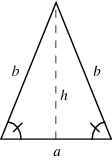
An isosceles triangle is a triangle with (at least) two equal sides. In the figure above, the two equal sides have length ![]() and the remaining side has length
and the remaining side has length ![]() . This property is equivalent to two angles of the triangle being equal. An isosceles triangle therefore has both two equal sides and two equal angles. The name derives from the Greek iso (same) and skelos (leg).
. This property is equivalent to two angles of the triangle being equal. An isosceles triangle therefore has both two equal sides and two equal angles. The name derives from the Greek iso (same) and skelos (leg).
A triangle with all sides equal is called an equilateral triangle, and a triangle with no sides equal is called a scalene triangle. An equilateral triangle is therefore a special case of an isosceles triangle having not just two, but all three sides and angles equal. Another special case of an isosceles triangle is the isosceles right triangle.
For golf, let us not dwell on the other special isosceles triangle but just the one pictured above. Picture your shoulders as the side "a" and the sides "b" as the distance of both shoulders to the ball. On the upswing, the "b" sides will no longer be equal - the left getting longer and the right getting shorter. You can test this by facing both hands together and looking how the left hand gets shorter in relation to the right hand while moving the shoulders around and the arms moving up. What happens, technically speaking, is the face of the club or putter opens up. To get it back to the square position (the isosceles triangle), one has to let the shoulders wait for the hands to catch up at the point of impact.
Have you not noticed that when you really want to hammer the ball and let the body work more - the ball slices? Yes, that is the body not waiting for the arms (the other way around - hook - is possible but usually new golfers cannot do this). Now that you know the technical stuff, let us go to the practical side.
Here is another fallacy I have been advocating before, "The technique follows the same intention as the full swing - use the big muscles for consistent accuracy." Well not entirely wrong in a way - this statement is correct when you think of the putt as two pieces. The first is the big muscles; the second is a rebound with the absence of the big muscles. Sounds confusing isn't it?
- First, practice how hard you far you want the ball to go.
- When satisfied, lay down the club with the left hand roughly square to the target, both feet together.
- Start aiming the club to the target while the right hand joins in to fully grip the club.
- With both hands now on the club, finish the targeting of the putter face to the target.
- Once satisfied and while still looking at the target, move the feet apart for the proper stance.
- Start the back swing with shoulders up to the point you previously (first bullet) practiced.
- With the shoulders relaxing, let the putter bounce back with the arms guiding it back to the target.
- The isosceles triangle is achieved at point of impact - then becomes a scalene triangle again after impact. Note that the reverse scalene triangle happened at the upswing also.